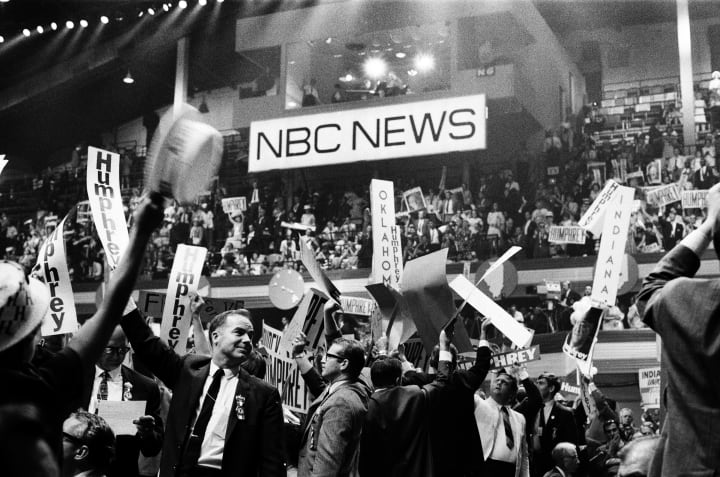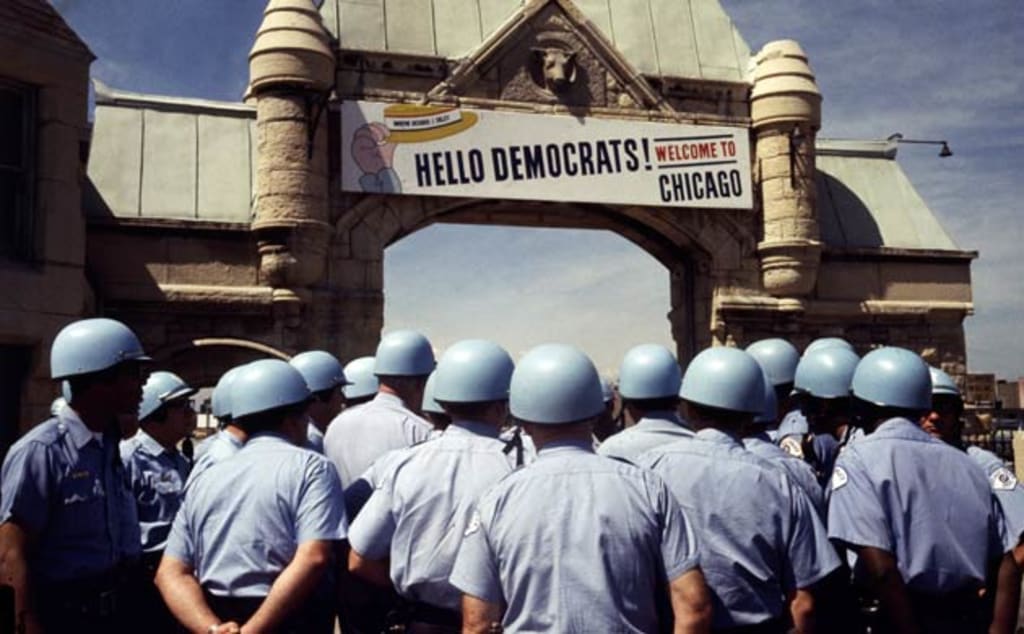With the height of protesting the Vietnam War, the Democratic National Convention turned violent, on the inside and out, when police officers patrolling the convention started beating protesters in the streets on national television.
The numerous events that led to the Democratic National Convention (DNC) in 1968 were both challenging and heartbreaking. The assassination of civil rights activist Martin Luther King Jr. and Robert F. Kennedy, the peak of the Vietnam War, and Lyndon B. Johnson’s withdrawal from running for re-election each shaped not only the year 1968 but the all-important race for the presidency as well. With the height of protesting the Vietnam War, the Democratic National Convention turned violent, on the inside and out, when police officers patrolling the convention started beating protesters in the streets on national television.
The year 1968 was historic in defining American culture for the next 50 years. President Johnson started his presidency on November 22, 1963, after John F. Kennedy was assassinated in Dallas, Texas, campaigning for his re-election the following year. Despite the worst way one would want to enter the presidency, LBJ ensured that JFK’s exact civil rights bill would be passed in 1964 (the Civil Rights Act of 1964). The Voting Rights Act in 1965 was also passed, which allowed black Americans the right to vote under the 15th Amendment to the U.S. Constitution.
Although he made an enormous amount of progress on civil rights in the United States during his short presidency, the war raging in Southeast Asia is what killed LBJ’s chance at re-election. On March 31, 1968, after an announcement about the halting of bombings happening in Vietnam, Johnson dropped a bombshell. “I shall not seek, and I will not accept, the nomination of my party for another term as your President” were the lines that stayed with the American people forever—including a certain candidate.

Just two weeks before Johnson’s announcement, Robert F. Kennedy finally declared that he was going to run for president. With LBJ finally out of the running, it seemed like it would be a smooth ride to becoming the Democratic Party’s nominee for the presidency, as long as he performed well throughout the primaries. Kennedy had been very hesitant about openly contesting a sitting president, which is why it took him so long to announce his bid, as well as losing him a huge chunk of his key demographic: college students.
Eugene McCarthy was the first democratic candidate to openly challenge Johnson for the presidency. The senator from Minnesota had a large backing from college students and young voters, as his whole campaign was challenging the current administration about how unnecessary the Vietnam War was. McCarthy was performing well against Kennedy during the primaries and even managed to pull out a win in Oregon, beating Kennedy 45 to 39 percent.
Once Johnson announced he would not be running for a second term as President of the United States, the current vice president, Hubert Humphrey, became the immediate choice as his predecessor. With Johnson’s sway, Humphrey was already backed by the Democratic Party, and he easily secured enough delegates to win at the convention.
With the tragic deaths of Martin Luther King Jr. and candidate Robert Kennedy, the Democratic National Convention meant more now than it ever had before. With so many integral leaders being killed for wanting a better version of America, it was time to select the perfect candidate to lead the party in the right direction.
Thus, began the four days of the Democratic National Convention.

The DNC was held from August 26 to 29 at Chicago’s International Amphitheatre. Inside the convention, journalists were being pushed around by security while reporting on the happenings on the convention floor. On the outside, more was to come.
To show their disgust for how they felt about their political party, an anti-war protest group called the Youth International Party (Yippies) organized an event five miles north of where the convention was taking place. Along with the National Mobilization Committee to End the War in Vietnam and the Students for a Democratic Society (SDS), the protestors crowded the park that coincided with the convention. Around 10,000 demonstrators gathered in Lincoln Park, Grant Park, and other areas around Chicago but were met with 23,000 police and National Guardsmen.
On August 28, during the mid-afternoon, a young man lowered the American flag that was flying in Grant Park. From that moment on, everything spun out of control. The police and National Guardsmen broke through the crowd and started beating demonstrators with billy clubs and using tear gas on them. The amount of tear gas used was so strong that it filtered throughout the city and even disturbed Humphrey while he was showering.
Just as the entire year was filled with chaos, the scene of Chicago that night was something that couldn’t possibly be happening in the United States.
For 17 minutes under bright television lights, America saw demonstrators being beat by law enforcement that was supposed to ensure their safety. While chanting, “The whole world is watching,” the Democratic Party was torn even further apart. This separation allowed for the “law and order” candidate Richard Nixon to remain uncontested on the Republican side and ultimately win the presidency in 1968.
After a year of violence, political mayhem, and civil unrest, America would never be the same. It’s still so easy to see the political climate of today and compare it to that of 1968. Bigotry still wins, people of colour are still at a disadvantage, and we are still marching for our rights. The Democratic Party is still indecisive on which route they plan on taking. The year 1968 was an outlier, but are we really that far off from today?

